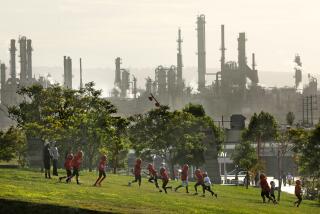Yaroslavsky Would Shut 2 Power Plants to Cut Smog
- Share via
Two city-owned power plants, including one in the San Fernando Valley, produce too much air pollution and should be shut, Los Angeles City Councilman Zev Yaroslavsky said Thursday.
The plants in Sun Valley and San Pedro generate 8% of the electricity produced by the city’s four power plants in the Los Angeles Basin, Yaroslavsky said. Yet, they account for 20% of the nitrogen oxides emitted by the four plants.
Yaroslavsky, who is expected to run against Mayor Tom Bradley in 1989, called for the plant shutdowns while unveiling a series of measures to reduce smog, such as replacing the city’s gas-burning fleet of vehicles with methanol-powered ones.
Later, in a statement, Bradley said the councilman’s proposal was “ill-considered.”
“Although the Harbor and Valley Generating Stations are currently used at a minimum level, their suggested shutdown would jeopardize the reliability of the city’s electrical system,” the mayor said. “It would create a situation in which the DWP is not able to meet the electrical needs of all of our 3.5 million residents.
“Further, if this ill-considered recommendation were actually implemented, residents in the San Fernando Valley and the Harbor area could be subjected to periodic ‘brownouts’ during periods of peak electrical usage.”
The final decision on the plant shutdowns rests with the Board of Water and Power Commissioners, appointed by the mayor. A spokesman for the Department of Water and Power said there is no plan to close the plants.
Eldon Cotton, DWP assistant chief engineer of the power system, said the Sun Valley plant, built in the 1950s, is little used but needed during emergencies and periods of high demand for electricity.
Cotton said emissions from the plant are infinitesimal compared with other sources of pollution. “All of our power plants combined account for only 1% of the total emissions in the Los Angeles Basin,” he said.
Cotton said the department has reduced emissions at its power plants in the basin by 90% over the last 10 years by tapping sources of electricity outside the city. He said the department is planning to use experimental technology to reduce emissions at its Long Beach plant, and the techniques will be applied to other plants if successful.
1% Share
The Valley plant, at 9430 San Fernando Road, produces less than 1% of the city’s electricity and 3% of the power produced by the city’s four plants in the Los Angeles Basin, according to the city’s legislative analyst. Most of the city’s electricity comes from sources outside Los Angeles.
The Valley plant emitted 224 tons of nitrogen oxide in 1986, or nearly 10% of the nitrogen oxides produced by the four basin plants, the legislative analyst said.
By contrast, the Chevron USA refinery in El Segundo, first on a list of top-20 polluters in the Los Angeles area compiled by the South Coast Air Quality Management District, emitted 5,418 tons of nitrogen oxides last year. No Valley sites are on the list.
A district spokesman said the Sun Valley plant could be considered “one of the largest single sources of pollution in the Valley, but, frankly, the biggest polluter is the motor vehicle.”
In the Los Angeles Basin, 71% of nitrogen oxide emissions come from motor vehicles, the spokesman said.
There have been no reports of health problems from residents who live near the Valley plant, he said.
More to Read
Sign up for Essential California
The most important California stories and recommendations in your inbox every morning.
You may occasionally receive promotional content from the Los Angeles Times.











